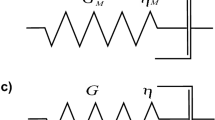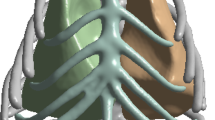Abstract
A simplified finite element model of a human thorax had been developed for probing into the mechanical response in simple and complex blast environments. The human thorax model was first created by CT images with blast loading applied via a coupled arbitrary Lagrangian–Eulerian method, allowing for a variety of loads to be considered. The goal is to analyze the maximum stress distributions of lung tissue and peak inward thorax wall velocity and to know the possible regions and levels of lung injury. In parallel, a mathematical model has been modified from the Lobdell model to investigate the detailed percentage of lung injury at each level. The blast loadings around the human thorax were obtained from the finite element model, and were then applied in the mathematical model as the boundary conditions to predict the normalized work of the human thorax lung. The present results are found in agreement with the modified Bowen curves and the results predicted by Axelsson’s model.
Graphic Abstract
Probability of different injury levels is predicted by the normalized work in seven scenarios, as could be seen in Fig. 12. The results indicate that the level of lung injury was higher when the human thorax was located in a complex environment. In general, the level of lung injury increases with the total normalized work.















Similar content being viewed by others
References
Argyros, G.J.: Management of primary blast injury. Toxicology 121, 105–115 (1997)
Yang, Z., Wang, Z., Tang, C., et al.: Biological effects of weak blast waves and safety limits for internal organ injury in the human body. J Trauma 40, 81–88 (1996)
Bellamy, R.F., Zajtchuk, R.: Conventional warfare: ballistic, blast, and burn injuries. In: Bellamy, R.F., Zajtchuk, R. (eds.) Textbook of Military Medicine, Part 1, vol. 5, pp. 1–51. Office of the Surgeon General of the US Army, Washington, DC (1991)
Cooper, G.J., Taylor, D.E.M.: Biophysics of impact injury to the chest and abdomen. J R Army Med Corps 135, 58–67 (1989)
Januszkiewicz, A.J., Mundie, T.G., Dodd, K.T.: Maximal exercise performance-impairing effects of simulated blast overpressure in sheep. Toxicology 121, 51–63 (1997)
Bowen, I.G., Fletcher, E.R., Richmond, D.R.: Estimate of Man’s Tolerance to the Direct Effects of Air Blast. Technical Progress Report No. DASA-2113. Department of Defense, Defense Atomic Support Agency, Washington, DC (1968)
Bowen, I.G., Fletcher, E.R., Richmond, D.R., et al.: Biophysical mechanisms and scaling procedures applicable in assessing responses of the thorax energized by air-blast overpressures or by nonpenetrating missiles. Ann N Y Acad Sci 152, 122–146 (1968)
Bass. C.R., Rafaels, K., Salzar, R.: Pulmonary Injury Risk Assessment for Short-Duration Blasts. In: Proceedings of Personal Armour Systems Symposium (PASS), Leeds (2006)
Gruss, E.: A correction for primary blast injury criteria. J Trauma 6, 1284–1289 (2006)
Axelsson, H., Yelverton, J.T.: Chest wall velocity as a predictor of nonauditory blast injury in a complex wave environment. J Trauma 40, S31–S37 (1996)
Stuhmiller, J., Chuong, C., Phillips, Y., et al.: Computer modeling of thoracic response to blast. J Trauma 28, S232–S239 (1988)
Stuhmiller, J.H., Vorst, M., Dodd, K., et al.: A model of blast overpressure in jury to the lung. J Biomech 29, 227–234 (1996)
Stuhmiller, J.H.: Biological response to blast overpressure: a summary of modeling. Toxicology 121, 91–103 (1997)
D’yachenko, A.I., Manyuhina, O.V.: Modeling of weak blast wave propagation in the lung. J Biomech 39, 2113–2122 (2006)
Greer, A.D.: Numerical Modeling for the Prediction of Primary Blast Injury to the Lung. University of Waterloo, Waterloo (2006)
Cronin, D., Greer, A., Williams, K., et al.: Numerical modeling of blast trauma to the human torso. In: Proceedings of the Personal Armour Systems Symposium (PASS), pp. 323–332, The Hague (2004)
Gefen, A., Elad, D., Shiner, R.J.: Analysis of stress distribution in the alveolar septa of normal and simulated emphysematic lungs. J Biomech 32, 891–897 (1999)
Gefen, A., Halpern, P., Shiner, R.J., et al.: Analysis of mechanical stresses within the alveolar septa leading to pulmonary edema. Technol Health Care 9, 257–267 (2001)
Wang, H.C.: Development of a Side Impact Finite Element Human Thoracic Model. Wayne State University, Detroit (1995)
Chang, H.T.: The Development, Validation and Comparison of a Finite Element Human Thorax Model for Automotive Impact Injury Studies. The University of Lowa, Lowa (2001)
Hallquist, J.: LS-DYNA User’s Manual ver. 970. Livermore Software Technology Corporation, Livermore (2006)
Lobdell, T.E., Kroell, C.K., Schneider, D.C., et al.: Impact response of the human thorax. In: King, W.F., Mertz, H.J. (eds.) Human Impact Response Measurement and Simulation, pp. 201–245. Plenum Press, New York (1973)
Viano, D.C.: Evaluation of the benefit of energy-absorbing materials for side impact protection. In: Proceedings of the 31st Stapp Car Crash Conference. SAE Paper No. 872213, pp. 185–224, Society of Automotive Engineers, Warrendale, Pa (1987)
Author information
Authors and Affiliations
Corresponding author
Rights and permissions
About this article
Cite this article
Zhou, J., Tao, G. Biomechanical modeling for the response of human thorax to blast waves. Acta Mech. Sin. 31, 589–598 (2015). https://doi.org/10.1007/s10409-015-0419-4
Received:
Revised:
Accepted:
Published:
Issue Date:
DOI: https://doi.org/10.1007/s10409-015-0419-4




